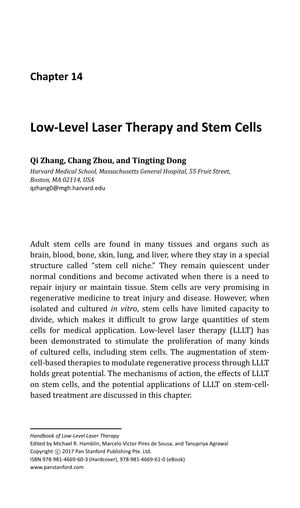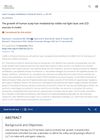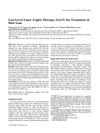Chapter 14 Low-Level Laser Therapy and Stem Cells
August 2016

TLDR Low-level laser therapy may help stem cells grow and function better, aiding in healing and tissue repair.
The 2016 chapter outlines the potential benefits of low-level laser therapy (LLLT) in regenerative medicine, particularly its ability to enhance stem cell proliferation and function. LLLT, which uses red or near-infrared light, activates mitochondrial cytochrome c oxidase, leading to increased ATP production and the activation of cell survival and proliferation pathways. It has shown positive effects in clinical and pre-clinical studies, such as reducing pain, controlling inflammation, aiding wound healing, and tissue regeneration, without toxic side effects. The therapy has been effective in stimulating the proliferation of mesenchymal stem cells (MSCs) and adipose-derived stem cells (ADSCs) within specific energy density and wavelength ranges. In the context of hair loss, LLLT has increased hair counts in individuals with androgenetic alopecia, potentially by stimulating epidermal stem cells in hair follicles. Despite these findings, optimal LLLT parameters are not fully established, and there is a need for more research to understand the mechanisms and standardize doses.
View this study on taylorfrancis.com →
Cited in this study

research Efficacy and Safety of a Low-level Laser Device in the Treatment of Male and Female Pattern Hair Loss: A Multicenter, Randomized, Sham Device-controlled, Double-blind Study
Laser device increases hair density, safe for treating hair loss in men and women.

research The growth of human scalp hair mediated by visible red light laser and LED sources in males
Red light therapy at 655 nm significantly improved hair growth in men with hair loss.

research Low‐level laser (light) therapy (LLLT) for treatment of hair loss
Low-Level Laser Therapy is effective and safe for hair growth with minimal side effects.